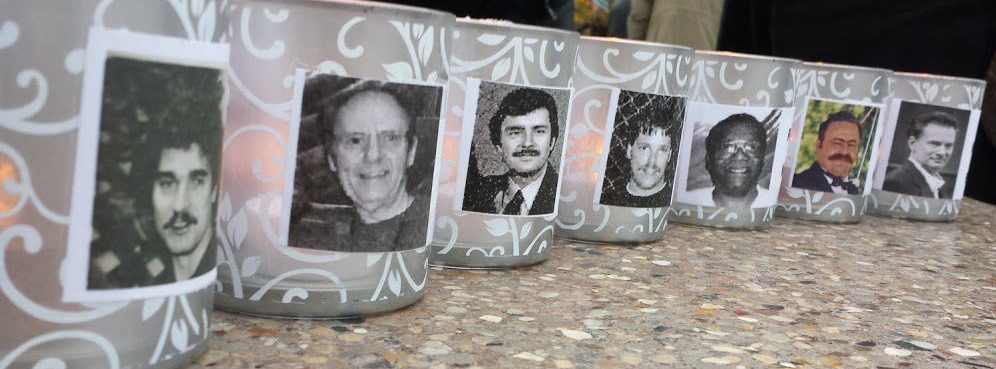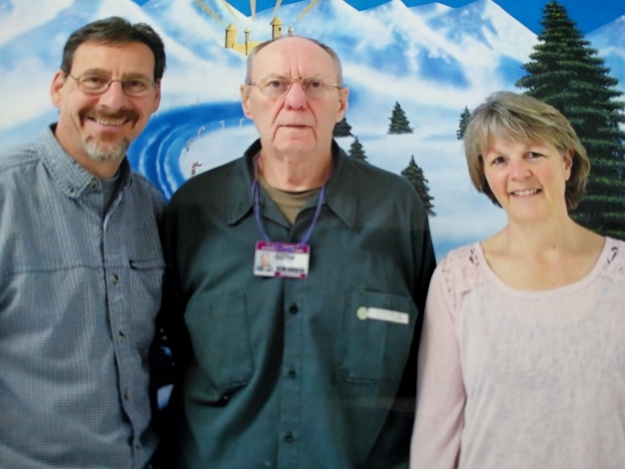This is a collect call from… “Michael.” To accept charges…press one.
(Beep) Connection established.
“Hello Joan and Mike,” the familiar voice said…

Michael Hirn, an innocent man imprisoned for over twenty-three years, was calling from McNaughton Correctional Center; a minimum security prison in Tomahawk, WI. The previous evening, he had tried calling us three times. Regrettably, my husband, Mike and I had missed those calls. Between bouts of sleep that night, I pondered the most likely reason for them. Maybe Michael was actually going to be paroled after all…
Michael had alluded to this possibility in a few of his recent letters but I was skeptical. Aside from Michael Piaskowski’s exoneration in 2001, only one other of these men has ever been paroled. All other bids for parole by Piaskowski’s co-defendants have repeatedly been denied…until extreme circumstances forced the hand of the Wisconsin Parole Commission in September of 2017. At that time Dale Basten, the oldest of the men (aged 77), was given what is called compassionate release; “…a process by which inmates in criminal justice systems may be eligible for immediate early release on grounds of particularly extraordinary or compelling circumstances.” (Wikipedia) I believe Dale’s deteriorating physical and mental capacity coupled with mounting medical bills were the only motivating factors for his release. Tragically, Dale passed away the following year in June of 2018.

Mike and me with Dale Basten during a prison visit on 12-27-2015
WBAY story about Dale’s release.
WBAY story about Dale’s passing.
The next morning I emailed Tom, also a close friend of Michael’s. They spoke on the phone often so he’d know what was up. Sure enough, Tom confirmed my suspicions. “Mike was calling to let you know that he’s been granted parole,” Tom wrote. “He wanted to tell you himself.” Tom also explained that Michael would most likely be released….and soon.
As Mike and I eagerly waited for the automated system to connect us, I almost wished we didn’t know yet what Michael had tried to call us about. I felt we had robbed him of being the first to deliver this surprise. Still, trying to imagine how he must be feeling gave me goosebumps. But another voice deep within warned me to be cautious about the likelihood of his actual release. I was under the assumption that being granted parole required admitting guilt for the given crime and showing remorse. And I knew from talking to each of the men that they will never sacrifice their integrity by admitting to something they did not do. The question remained in my mind. Was the parole board really going to overlook this non-admission of guilt?
During our brief conversation Michael reiterated what Tom had said. He reassured us that he was going to be released the week before Christmas. He thought it would happen on Wednesday, December 19th. After our conversation, it started to sink in that this was becoming a reality. “This is our next miracle,” I said to my husband.
Michael and his family wanted his discharge to be private. They only wanted to be left alone, to relish in this triumph without the intrusion from the media or from those with less savory opinions. But that idea was squashed when news stories and articles started to surface about Michael’s impending release. I only found out that this information had reached the media through a text I received from a local reporter from WBAY looking for a comment. At first there was mere speculation about a specific time frame but more accurate details slowly surfaced and circulated to various news outlets in Green Bay. It was looking like this would happen on Tuesday, December 18, 2018 at 8:00 a.m. Mike and I discussed travel plans. We were not about to miss one of the most extraordinary steps of this journey that we were on!

Mike and I, my sister, Clare and her boyfriend, Gary checked into a motel near the prison on Monday night. The following morning I was scheduled to do an early interview with Steve Hopper, photojournalist from WBAY Ch. 2 (Green Bay), Shortly after seven a.m. Mike and I spotted Steve’s vehicle just outside the prison gates as dawn’s earliest light began to appear. Our friend Deb was there also. Clare and Gary showed up a little later. We all piled into warm vehicles after the interview was over. We waited…

My interview with photojournalist Steve Hopper
A short time later a man pulled up in a gray pickup and parked along the opposite side of the road from us. He glanced in our direction with a pained look. I could see he was on the verge of tears. As he climbed out of his vehicle and headed in our direction, I was fairly certain that it was Michael’s Aunt Marlene and Uncle Terry’s son, Randy. He and I had communicated through emails prior to that day and Randy assured me that he’d be there that morning. As I walked toward him he asked, “Are you Joan?” “Yes,” I said. He hugged me tight and expressed his deep gratitude. We both did our best to contain the tears.

Meeting Randy
The mood lightened a bit as the others gathered around to meet Randy and to share in this awe-inspiring moment. “My parents are up by the prison entrance waiting for Michael to come out,” Randy said. He then drove up the driveway in that direction hoping to also be there to support them. We all followed in our cars and parked in the visitor lot. I opened my door and heard Randy’s voice. “They are in their eighties,” Randy pleaded with the corrections officer. “I want to be there with them.” Unfortunately all of us, including Randy, were asked to go back and park on the road outside the gates.

The gates as you enter McNaughton Correctional Center
Finally…at approximately 7:45, we caught sight of a bright red pickup truck coming toward us down the driveway from inside the prison gates. The truck stopped just short of passing through them. Michael Hirn, looking taller and slimmer than we remembered, exited the passenger side of the vehicle and walked with dignity as he took his final steps on foot toward freedom. He was leaving the McNaughton Correctional Center and prison life for good.

Michael Hirn walking toward freedom. (Photo courtesy of WBAY)
I describe those steps as his final ones because Michael had taken many of them over the years to achieve this goal. I felt it necessary to point that out when asked to submit a comment for this Green Bay Press Gazette article. Published days before Michael’s release, I felt these words adequately summarize the true character of this man: “People must understand that this (parole) was not simply handed to him,” said Treppa, who met all six men as part of the research for a book of her own, Reclaiming Lives: Pursuing Justice For Six Innocent Men. “He earned it through hard work, diligence, patience and a positive attitude. I believe that, in moving forward, being angry over something he cannot change will never define who this man is.”

My first hug from Michael after he was freed, with Clare and Randy looking on
With only the utmost respect for someone who is destined to become an effective spokesperson for the other men, I offer this recurring mantra found in many of Michael Hirn’s letters to me: “I’m serious about my intentions to be an advocate for prison reform once I’m exonerated,” he would write. I believe that his understanding of the dynamics of this case, his ability to curb his anger over these unlawful convictions, and his sheer determination to forge ahead, will open up new avenues to exoneration for them all.
Mark Saxenmeyer; producer of the up and coming docuseries titled Guilty Until Proven Innocent (highlighting stories of wrongful conviction including the Monfils case), his videographer, Joe Pollock, and Steve Hopper (WBAY) were set up and ready to record this important and historic event that infers increased hope of eventual freedom for the remaining incarcerated men. Hoping for an opportunity to actually speak with Michael, they stood patiently and respectfully on the sidelines, filming, snapping photos, and capturing poignant moments amid hugs, tears, smiles and relief as we all gathered to congratulate this now free man on this remarkable day.
The awesome procession we witnessed as Michael was escorted off of the prison grounds was indescribable…and appropriate. In fact, during our visit with Michael on April 18, 2015, Mike and I had the pleasure of meeting the two people who were given that opportunity. We will never forget this encounter which captures the essence and the scope of this ongoing tragedy:
Forty minutes into our visit, a guard came to ask if it was okay for two other visitors to join us. Michael’s Aunt Marlene and Uncle Terry arrived at the front desk. I had met a few of Michael’s closest family members—his son, Tyler, and stepfather, Mike Dalebroux. And each year we receive a Christmas card and newsletter from Michael with a picture of him and Tyler. Mike Dalebroux comes to our Walks and speaks highly of his stepson. Marlene and Terry have shown their support over the years by driving a long distance to visit Michael. When they came into the lounge, Michael introduced us and mentioned my involvement. Marlene thanked and hugged me as tears filled her eyes. Looking at Michael, she remarked, “I don’t know how you maintain such a positive attitude under these circumstances.” Michael said it was the support from us and many others that kept him strong.
Michael smiled in the photos we’d had taken. Marlene and Terry opted out of engaging in any. “We are waiting until after Michael is released,” Marlene said. – Excerpt from Reclaiming Lives

Fox Lake Correctional where Mike and I first met Marlene and Terry during our visit with Michael Hirn in 2015
What makes Michael’s release particularly extraordinary aside from its realization…is its delay. Years after the verdicts were rendered and prior to his retirement in 2004, Judge James Bayorgeon (original 1995 trial judge) wrote an open letter to the Parole Commission on behalf of each of the six men, with this directive: “I believe (insertion of each name) should be granted parole at the earliest possible date.” But given the fact that Michael Hirn’s first bid for parole in 2010 was denied, and that all successive bids for parole since have been denied, it appears that this directive has been blatantly ignored by the Commission for far too long. With Michael’s unexpected release, I am very encouraged that the tide is now changing in this regard.
And rightly so. The list of facts suggesting the absolute innocence of all of these men is quite long. These few details related to Michael’s wrongful conviction are just the tip of the iceberg in a case plagued with missteps and illegal actions perpetrated by the authorities. During the original investigation into the Monfils case, Michael Hirn readily took four polygraph tests. In fact, he and all six of these men took multiple tests and passed them all. In my book I describe an instance where the lead detective tried (in vain) to disrupt at least some of those tests while they were being administered. Michael also pushed for FBI involvement during the investigation. Although the FBI was involved initially, their inquiry was brief. Why? The reasons for this are still unclear. Even now, many common sense questions remain unanswered about this case. One I hear often suggests the unlikelihood that these men would remain silent all of these years when sharing crucial information about Tom Monfils’ death could increase their chances for parole. And why would a guilty person push for FBI involvement?
And while the quest to free the remaining three men continues, we focus on the positive, and cherish the gifts given to us at a moment’s notice. We stand tall alongside our fellow crusaders in times of utter grief and unbelievable joy. Because this is the right thing…the only thing to do!
So while Michael was being interviewed the day of his release, I reminisced with Marlene and Terry about the memory of the prison visit. “Now you can finally have your photo taken with Mike,” I said excitedly to Marlene. The smile that appeared on her face was worth a thousand unspoken words. And similar to the visit at the prison which now felt like a thousand lifetimes ago, Marlene thanked me as she clung to me and to the newfound joy in her heart…as tears once again filled her eyes.

(L to R) My husband Mike, Randy, Marlene, Michael Hirn, me and Terry. Taken at the Beacon’s of Minocqua, the resort where Michael was employed as part of a work-release program. Michael wanted to show us the 24′ tree (behind us) that he helped to decorate. He also wanted to say “goodbye” to Mary, the resort director, and to everyone he befriended during his employment at the resort
Shorter version of story about Michael Hirn on WBAY.
Longer version of story about Michael Hirn on WBAY.
For additional information about this case i.e., news clips, court briefs, etc. check out The Monfils Case Revisited on the sidebar.
Read about Michael and the other five men by ordering my book on Amazon or on this website (top right) to receive a signed copy. Thank you!






